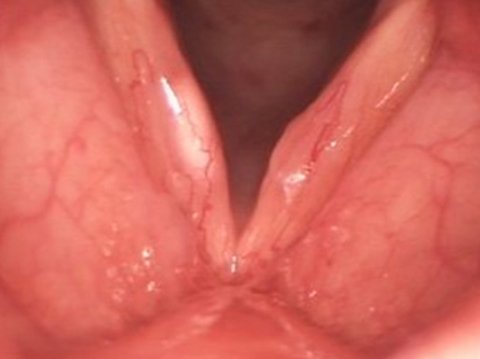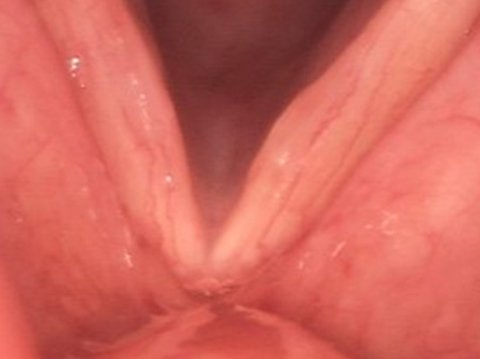When is voice surgery indicated for vocal cord cysts?
Indications for voice surgery of a vocal cord cyst:
- Hoarseness, rough voice
- Rapid vocal fatigue
- Impairment of breathing
A vocal cord cyst normally manifests as a lesion of round to oval shape unilaterally localized in the vocal fold body. The size of vocal cord cysts can vary considerably. Smaller cysts only cause minor changes in voice quality; larger vocal cord cysts cause severe hoarseness.
Aphonia has also been observed in conjunction with vocal cord cysts.
The indication for surgery is rendered based on the subjective clinical picture. Hoarseness perceived by the patient as an impairment should always be managed surgically. Likewise, only the very large vocal cord cysts impair breathing. If that is the case, then there is no time to waste in undertaking the surgical intervention.
Vocal cord cyst before surgery

Vocal cord cyst after surgery

Speech recording: Vocal cord cyst before surgery
Speech recording: Vocal cord cyst after surgery

How is voice surgery for a vocal cord cyst performed?
Because vocal cord cysts affect Reinke's space — the tissue layer underneath the vocal fold surface — the vocal fold body must be opened up down to the depth of the cyst.
For the surgical management of vocal cord cysts, Dr. Wohlt prefers the method of plastic reconstruction. The procedure starts with an appropriately long incision made lateral to the cyst, in other words on the side next to the cyst towards the ventricle. Through this incision, microdissection is performed to remove the cyst from the vocal fold body, at best in one whole piece.
Since the cyst is enclosed by a very thin membrane wall but filled to bursting with whitish-yellow fluid, the cyst will frequently burst and release the fluid that empties into the vocal fold body.
This basically presents no problem. However, care must be taken that the cyst sac is completely removed and no tissue residues are left behind in the vocal fold. If this happens, a cyst recurrence can develop.
After removal of the cyst, the wound cavity is examined scrupulously for any residual tissue from the cyst sac. Afterwards, the vocal fold is closed. This is usually accomplished by means of compression adaptation that relies on endogenous fibrin at the wound site. The use of tissue glues should be avoided.
Gluing, especially if too excessive, is always associated with the risk of promoting scarification.
Vocal cord cyst before surgery
Vocal cord cyst after surgery

What happens during the postoperative phase after surgery for a vocal cord cyst?
- Two-week period of vocal rest
- Abstinence from alcohol and smoking
- At least two months’ voice therapy
After surgery for a vocal cord cyst, a period of vocal rest lasting at least two weeks must be maintained. During this phase, healing of the wound and of the deeper tissue can take place.
Strict adherence to voice rest is imperative, particularly after this type of surgery where not only the superficial, but also the deeper tissue layers have been traumatized.
Even whispering should be avoided during this phase. Because nicotine impairs and delays wound healing, cigarette smoking should be avoided completely. During the wound healing phase, abstinence from drinking alcohol is also imperative to reduce any risk of bleeding.
It is also important that the 14-day period of vocal rest be followed by a program of voice therapy. Because the deep tissue layers have been traumatized by the surgery, the voice therapy program should extend over a period of at least two months. This training is necessary to dehabituate the vocal pressure patterns that had become ingrained in the patient over time. Ultimately, the duration of voice therapy depends on the isolated response of the patient to the individual exercises.




